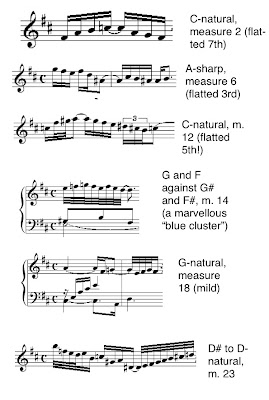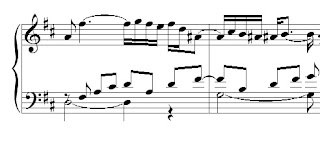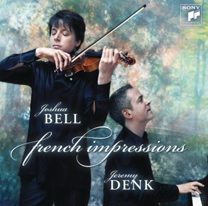It is rare, and delightful, when The Onion provides something themed perfectly for Think Denk; today is one of those magical, blessed days. All hail The Onion! (And also, the onion, a marvellous vegetable which was even used to pay rent in the Middle Ages.)
I was really bored one midmorning in Houston, at my hotel, with weekend downtown emptiness like a raging tornado of nothing around me, and I decided to count the “blue notes” in the Allemande of the 4th Partita. I assert there are 15, more or less! Here are the ones in the first half: 
Since my expertise in the blues is mainly limited to my Nina Simone album, the Onion article cited above, and occasional regrettable late evenings in Chicago in which many cigarettes were pretended to be smoked by me causing me to cough all my Caucasian pseudo-misery onto gentrified sidewalks, I had to do some scholarly research on Wikipedia:
In jazz and blues, blue notes are notes sung or played at a lower pitch than those of the major scale for expressive purposes. Typically the alteration is a semitone or less, but this varies among performers. The blue notes correspond approximately to the flattened third, flattened fifth, and flattened seventh scale degrees …
AHA! Though there was surprisingly no mention of Bach in the “blue note” article, nonetheless I felt triumphantly vindicated, and massaged my eyebrows pretentiously. All of the blue notes I found in the Allemande are flatted thirds, fifths, or sevenths, so there, and you nosy theorists who think I’m taking the term ridiculously out of context can just go (*&)*#@$&(*).
Bach sets us up in the “color” of D major, a beautifully voiced, lyrical D major—luminous, tender, warm—something which in no way augurs the blues; but then he begins to scatter little dark stars in his constellation. Why?
The first one that really really gets me is the A-sharp which sneaks in at the end of bar 5 (a flatted third). It appears (sour, bittersweet?) and then quickly seems to resolve itself away.
But clearly, this resolution is not “enough;” there is something left to deal with, because this little A#-event sets off a sweeping melodic figure (which I discussed yesterday) …

On the one hand, the blue note (folding inward, vanishing); on the other this gesture (leaping upward, overspanning); do these two events “follow,” do they make sense?
Blue Note … Lyrical Outpouring
Sadness … Gesture of Release
Perhaps they do follow, but not as balancing acts: there is no symmetry there, no “exchange value,” just a strange, instinctive call-and-response. The blue notes are charged with meaning, meaning that cannot always be addressed simply, or purely “musically,” and at every step they raise new complications, new considerations …
The Allemande’s amazing blueness occurs not because just one or two of these incidents happen, but that they keep happening, and they begin to resonate off each other; they accumulate, echo, create a second “text” overlapping the first, seeming to contradict it. That first A# is a warning, a seed. It engenders, as I have said, a family of “dissonant” appearances. And then, all the blue notes in the second half are recollections, reminiscences of the ones in the first half: that is, recollected transgressions, like mistakes that you’ve made, and choose to repeat. With the various blue notes circled in my score, it looks like some sort of weird code hidden in the page; I imagine each note as I play as a sort of “bump in the road,” and then there is a strange topography to the whole experience, like passing your hands over Bach’s blue braille.
At the risk of trivialization, let’s imagine Bach at the Blue Note at 2 am, letting it all hang out baby, thinking freeform. Empty whiskey glasses are strewn around the harpsichord bench, smoke curls in the air, the smoke of the minor key … the haze, the blurring of thought … the in-between, in-the-cracks notes, trying to wedge themselves in that incompromising space between the black and white keys. Bach’s looking for some way to disturb the serene discreteness of the keyboard, some way to press the same old levers, but in such a way as to question their identity. (Don’t let the notes tell you who you are, man.)
But Bach is not just being a rebel. The more I play it, the more I feel that these blue notes are not at all “antagonistically” related to the main major key, that the main question is not at all happy vs. sad. The blue notes make the Allemande “real” somehow, make me identify with the singer or the voice of the narrator of whatever you want to call it; he/she is vulnerable, occasionally falling apart, stricken in various ways, strung out, prone to digression, musing, changes of mood …
If Bach is “thinking about something” there in the Blue Note, perhaps it has something to do with the incredible vulnerability of beautiful things … the Allemande seems to me the only movement of the Partita which addresses this issue, which allows beauty to be seen offstage, unpropped: the Gigue is overtly, virtuosically, audaciously joyful; the French Overture is grand, pompous, stylized; even the Sarabande seems safe in its melismatic D major world. But the particular fragility of mood in this movement is something very special, something that cannot be summarized by “sadness made transcendent” or “bittersweet” or any number of epithets I have considered. The closest I have come is this: when you are seeing or experiencing some incredibly beautiful thing, in the flash of recognition, how even the ramble of your own mind, the ticking of a few seconds, some restlessness or disturbance, makes you realize how even your perception and experience are utterly temporary, insufficient for the beauty you are experiencing, and yet the only tool you have.




6 Comments
Jeremy, your Bach partitas are out of this world, but
have you tried playing it on harpsichord?
You know, I’ve just performed this Partita five times in the past three weeks (last recital was tonight), and I must admit, shamefully, I’ve never stopped to count the blue notes.
Thanks for doing it for us. 🙂
Let me greet you Happy Birthday for straight 6 days also!
Partita Schmartita. Great works of art to sustain us. Question is, are WE creating anything worth mentioning. Anything new. I am tired of hearing the same things over and over and over and over and over and over again. A culture of preservation, creating nothing.
Right on! Destroy the museums! Burn old scores! Make room for new life!
You can destroy all you want (I am NOT FOR destroying the “classics”) you will still be left with your uncreative, uninspired self.